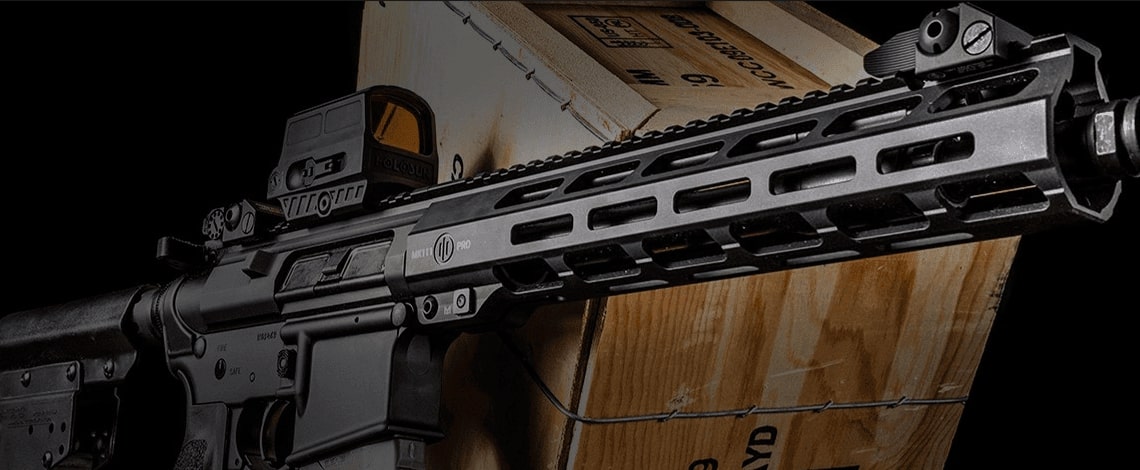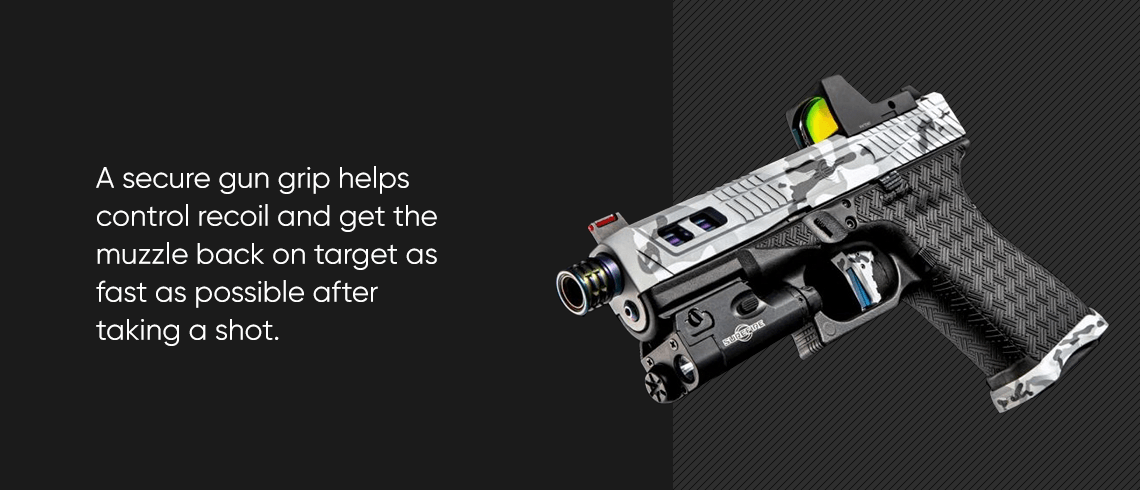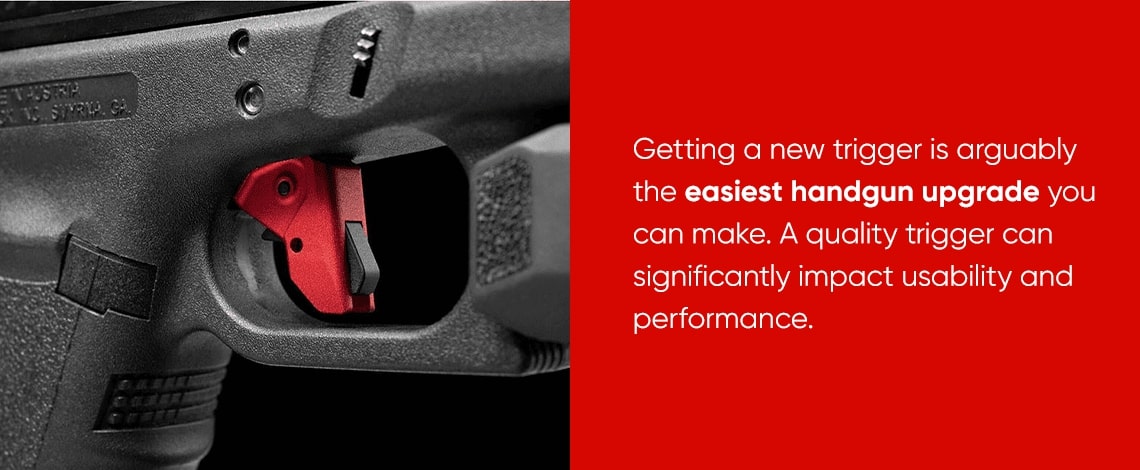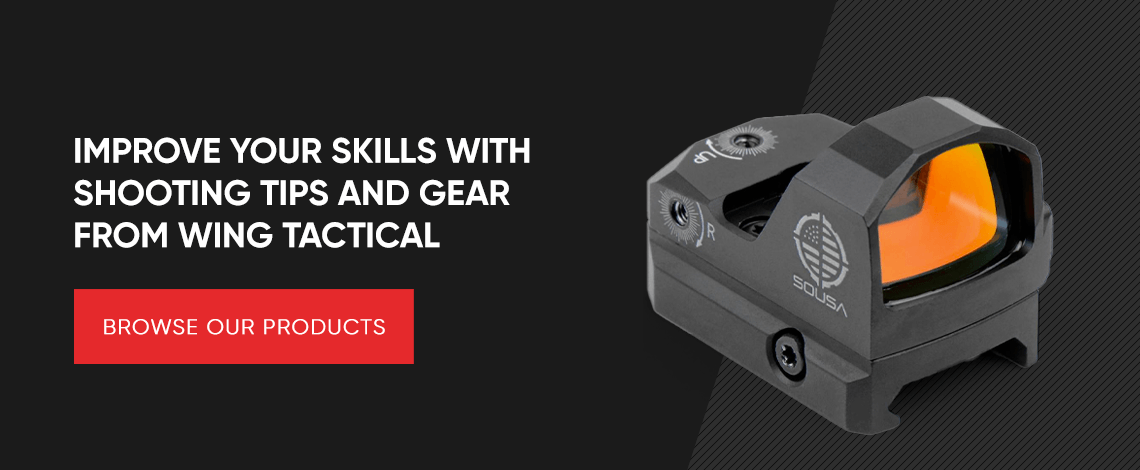
Whether you're new to the world of firearms or you're a seasoned pro, there's always room to grow your skills. From getting to know your gun to working on stance and trigger control, these are crucial techniques requiring time and practice to refine over time. Improve your shooting skills with the essential tips and tricks in this article.
Get Comfortable Handling Your Gun
Handling your firearm comfortably is a critical step in refining your shooting skills. Here are some tips for getting comfortable with your gun.
1. Understand Basic Gun Safety Rules
Getting comfortable with your gun involves examining and holding the firearm. However, it's vital to understand the basic gun safety rules before handling any firearm:
- Treat every firearm as if it's loaded.
- Keep your finger off the trigger until shooting the target.
- Never aim at anything you don't intend to shoot.
- Always point the gun in a safe direction.
- Don't load the gun until you're ready to use it.
2. Get to Know Your Firearm
Familiarizing yourself with your firearm is essential in improving your shooting skills, especially if you're new to this hobby. Empty the gun and spend some time holding it. Practice the essentials like breaking it down, cocking it, releasing the magazine, cleaning it and aiming it when you're at home.
The more you understand how to handle your firearm, the more comfortable you'll be when loading it and aiming it at a target.
3. Practice Your Grip
Knowing how to hold your firearm properly is another step to improve shooting precision. A secure gun grip helps control recoil and get the muzzle back on target as fast as possible after taking a shot. Luckily, practicing your grip at home is simple. With sufficient practice, your grip should become second nature each time you pick up your firearm.

Here are some handgun grip tips to help you shoot while comfortable and relaxed:
- Grasp the handgun under the frame and trigger guard with your support hand — don't cock the gun or touch the trigger.
- Open your shooting hand so your index finger and thumb form a V shape.
- Place the V high up on the frame so the gun rests securely in your shooting hand's palm.
- Curl your fingers around the handgun grip, extending your index finger along the side of the gun while keeping it off the trigger.
If you're shooting a rifle, your body will contact the firearm in four places:
- Grip under the trigger, where your dominant hand goes.
- Vertical grip fixture below the rail at the front of the rifle, where your nondominant hand goes.
- Stock weld, which rests against your dominant-side shoulder.
- Cheek weld, where you rest your dominant-side cheek atop the stock.
Your dominant-side grip will be your fire-control hand. Ensure you can manipulate the safety switches with this hand.
Because your rifle recoils upon firing and causes the gun's nose to rise, your nondominant hand actually receives the most impact. To control the front end of your rifle, wrap your thumb over the bore and your other four fingers underneath it. The vertical fixture should adjoin the rear of your palm.
Focus on Your Shooting Stance
A proper handgun shooting stance is as critical as your grip. Ensure both your feet are planted firmly on the ground about shoulder-width apart. Lean forward slightly. Using both hands, bring the gun directly in front of your eyes with both arms fully extended in front of you.
This isosceles stance keeps your head fully upright, allowing for optimal peripheral vision and naturally centering the pistol with your eyes. The more you practice an effective shooting stance and firm grip, the more efficient, accurate and confident you'll be at the range.
Here are the four main stances for rifle shooting.
1. Standing
Standing can be the most challenging position for accurate rifle shooting, as there's essentially no support besides muscle strength. However, it also offers the greatest target visibility of the four. Remember to stand perpendicular to the target with your feet about shoulder-width apart. This stance is less ideal for long distances and is more effective for short-range shots.
2. Sitting
The sitting position offers more arm support, but it's important to avoid elbow-to-kneecap contact. You can sit with your legs crossed or apart. You can also wrap your arm around your knee, resting the forestock against your bent arm. Hunters often use this position when sitting against a tree.
3. Kneeling
The kneeling stance involves placing your rear knee on the ground with your other leg supporting your forward arm's elbow. Try not to place your elbow on your kneecap, as this can cause you to wobble. Place the elbow on a muscle, like the quadriceps, instead.
4. Prone
The prone position involves lying on your stomach with your legs straight and elbows propped. It's generally the most accurate of the four, but the low angle can impede your view of the target if there's brush or tall grass present. It can also take more time to assume than the other stances.
Pay close attention to your rifle's muzzle — there's an increased risk of it contacting the ground and possibly getting lodged with mud or dirt. Additionally, remember not to stand up when holding the rifle. Place it on the ground first, stand up, then pick up the rifle.
Trigger Control
Jerking the trigger when firing at a target is a common mistake beginners make. Remember to apply pressure as slowly as possible to maintain good trigger control. This reduces muzzle movement during the shot. One of the best ways to improve trigger control is by practicing shooting drills, some of which we cover in the next section.
Great Drills to Increase Your Shooting Skills
Various shooting drills can help boost focus, control, breathing and accuracy. Here are some excellent drills to improve your shooting skills.

1. Dry Fire
The term "dry firing" means aiming your gun and pulling the trigger without a shell or cartridge in the chamber. It's a safe way to go through the motions of shooting a firearm without discharging it. It also helps improve trigger control, a key element in shooting performance.
Ensure your firearm is completely unloaded, and point the muzzle in a safe direction. Keep your finger off the trigger until you're ready to fire. The goal is to mimic an actual shot on a target, so you'll want to cover all of the steps you'd take before shooting.
If you're using a rifle, practicing with a bench or in a field shooting position — like squatting, kneeling or prone — is recommended. Practice looking at your target over the sights or through the scope and try to remain on target as the trigger breaks.
If you feel comfortable dry shooting and want to take it a step further, you can have someone hand you your gun either loaded or unloaded — with the muzzle pointed in a safe direction, as always — and deliver the shot without knowing if there's a cartridge in the chamber.
2. Breath Control
Proper breathing is another important drill for shooting. Breathing control prepares you to deliver an accurate shot. It reduces muzzle movement and prevents you from rushing your shot, thus increasing accuracy. The idea is to inhale, pause, fire your gun, then exhale. These steps can help steady your muzzle while aiming.
There are various techniques for breath control, but simplicity is key. When you're aiming at the target and preparing to fire, remember to take a few deep — but not exaggerated — breaths. After you inhale, slowly release about half of the breath until you're ready to shoot. You won't have excessive time to fire before you need more air, but you'll likely be more stable and relaxed when firing.
Restart your breathing cycle if you feel like you're running out of oxygen. This drill isn't meant to be rushed, so take as much time as you need to feel comfortable.
3. Near-Middle-Far
The "near-middle-far" technique is a valuable shooting drill for both rifle and pistol firing. It involves placing three targets at different ranges, such as 10, 15 and 20 feet. The process is straightforward — fire one shot at the closest target, one at the middle target, then one at the furthest target. Then, shoot them in reverse order from furthest to closest.
The near-middle-far drill helps you reevaluate your sight picture between shots. In most pistol shooting instances, you'll need to focus on the front sight every time you switch to a new target. This can help you build the habit of acquiring the front sight quickly. While it may sound counterintuitive, you should focus on the dot or reticle instead of the target if you're using an optic.
4. The Double Tap
While the "double tap" drill typically applies to defensive pistol shooting, it can benefit virtually any shooting discipline. The goal is simple with pistols — you want to shoot the center of the target, then quickly fire an accurate subsequent shot.
Accuracy is key here. You'll build speed with practice — if your second shot is off, it's likely a sign you delivered it too soon. Start slowly and follow the same pattern — fire, regain front sight focus, then fire again.
The double tap drill differs slightly with rifle shooting. You can fire these quick follow-up shots from a field position or bench, but the same goal of quickly placing two shots into the target remains. Similar to pistol shooting, ensure you're placing these shots accurately. Shooting accurately often means regaining your sight focus between shoots and not shooting too fast.
There's also a shotgun variation of double taps, which many competitive shooters call "shooting chips." When firing at a clay target, try breaking one of the target's pieces before it hits the ground. A benefit of this training is that it can prevent you from dropping the firearm after the shot and encourage follow-through, a critical skill with shotgun shooting. If you miss, you'll be ready to deliver another shot that may break the target.
5. Live-Fire at a Gun Range
Regardless of your skill level, shooting live rounds at a gun range is ultimately the best way to practice the above drills and accuracy tips, as well as get a feel for your gun when delivering rounds. The basic gun safety rules we discussed earlier also apply to shooting ranges. Here are some other important precautions to keep in mind:
- Ensure you're wearing eye and hearing protection before entering the range.
- Remain in the lane assigned to you.
- Keep your firearm unloaded until you're standing at the firing line and the range is "hot" — your gun should be unloaded when entering or exiting the range.
- Point the muzzle downrange at all times.
- Stop shooting immediately when someone calls "cease firing."
Try Accessories That Work Best for You
Having the right firearm parts is as critical as the shooting drills and other tips mentioned above. Here are some essential accessories to consider.
1. Triggers
Getting a new trigger is arguably the easiest handgun upgrade you can make. A quality trigger can significantly impact usability and performance. The type of trigger you choose for your firearm can determine its overall function, as certain types are designed for particular activities.

For hunting or competitive shooting, you'd likely want a two-stage trigger where you can pull back to the break wall, then wait until you line up your shot to fire. On the other hand, you might prefer a lighter single-stage trigger that delivers the shot instantly. A gun intended for self-defense might call for a heavier single-stage trigger requiring a more deliberate pull.
We have various custom handgun triggers and AR-15 triggers to choose from at Wing Tactical, so you can easily find what works best for you.
2. Sights
A good shot requires aim, and that's where having the correct sights for your gun comes in. Having backup AR-15 sights can come in handy if your optic loosens, loses power or goes missing. Additionally, most AR-15 iron sights are constructed from durable, long-lasting materials like aluminum, steel and polymer.
Whether you recently bought your first gun or you want to customize your current firearm, we have a range of AR-15 iron sights at competitive prices.
3. Grips
A good grip is essential for maintaining control of your firearm and improving your precision. For instance, when shooting in rough terrain, you'll likely want a durable pistol grip made from carbon fiber or aluminum.
uckily, we have an inventory of pistol grips at Wing Tactical. We have many lightweight, easy-to-handle options that offer the grip and comfort of a rubberized surface. Feel free to look through our product descriptions for manufacturing materials, colors, textures and grip angles.
Improve Your Skills With Shooting Tips and Gear From Wing Tactical
In addition to the tips above, having the right equipment is essential for improving your shooting skills. At Wing Tactical, we provide high-quality firearm parts and accessories for new and experienced shooters alike, whether you're a competitive shooter, hunter, police officer or gun hobbyist.
We offer benefits like law enforcement and military discounts, fast shipping, exceptional customer service and easy 30-day returns, so you can count on us to deliver the finest firearm components from the top industry brands.
Hone your shooting skills with top-notch gear and parts from Wing Tactical. Browse our firearm accessories or reach out with questions about finding the right parts!
